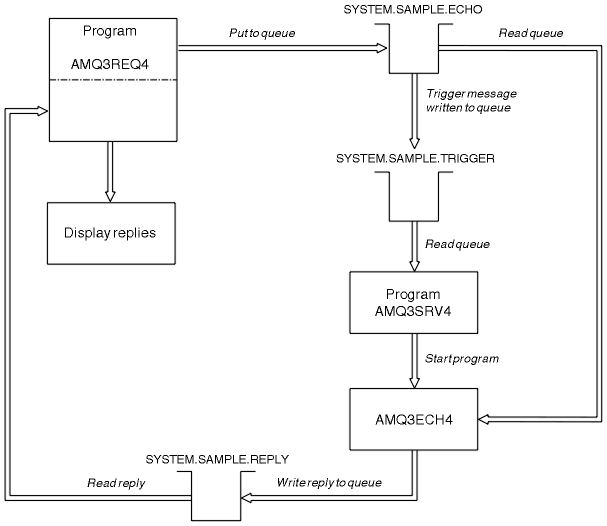The Request sample program on IBM i
The Request sample program, AMQ3REQ4, demonstrates client/server processing. The sample is the client that puts request messages on a queue that is processed by a server program. It waits for the server program to put a reply message on a reply-to queue.
The Request sample puts a series of request messages on a queue using the MQPUT call. These messages specify SYSTEM.SAMPLE.REPLY as the reply-to queue. The program waits for reply messages, then displays them. Replies are sent only if the target queue (which we will call the server queue ) is being processed by a server application, or if an application is triggered for that purpose (the Inquire and Set sample programs are designed to be triggered). The sample waits 5 minutes for the first reply to arrive (to allow time for a server application to be triggered) and 15 seconds for subsequent replies, but it can end without getting any replies.
To start the program, call the program and give the name of our target queue as a program parameter. The program puts a set of fixed messages on the queue; these messages are taken from the data block at the end of the program source code.
Design of the Request sample program
The program opens the server queue so that it can put messages. It uses the MQOPEN call with the OOOUT option. If it cannot open the queue, the program displays an error message containing the reason code returned by the MQOPEN call.
The program then opens the reply-to queue called SYSTEM.SAMPLE.REPLY so that it can get reply messages. For this, the program uses the MQOPEN call with the OOINPX option. If it cannot open the queue, the program displays an error message containing the reason code returned by the MQOPEN call.
For each line of input, the program then reads the text into a buffer and uses the MQPUT call to create a request message containing the text of that line. On this call the program uses the ROEXCD report option to request that any report messages sent about the request message will include the first 100 bytes of the message data. The program continues until either it reaches the end of the input or the MQPUT call fails.
The program then uses the MQGET call to remove reply messages from the queue, and displays the data contained in the replies. The MQGET call uses the GMWT option, specifying a wait interval (GMWI) of 5 minutes for the first reply (to allow time for a server application to be triggered) and 15 seconds for subsequent replies. The program waits for these periods if there is no message on the queue. If no message arrives before this interval expires, the call fails and returns the RC2033 (no message available) reason code. The call also uses the GMATM option, so messages longer than the declared buffer size are truncated.
The program demonstrates how we must clear the MDMID and MDCOD fields of the MQMD structure after each MQGET call because the call sets these fields to the values contained in the message it retrieves. Clearing these fields means that successive MQGET calls retrieve messages in the order in which the messages are held in the queue.
The program continues until either the MQGET call returns the RC2033 (no message available) reason code or the MQGET call fails. If the call fails, the program displays an error message that contains the reason code.
The program then closes both the server queue and the reply-to queue using the MQCLOSE call. Table 1 shows the changes to the Echo sample program necessary to run the Inquire and Set sample programs. Note: The details for the Echo sample program are included as a reference.| Program name | SYSTEM/SAMPLE queue | Program started |
|---|---|---|
| Echo | ECHO | AMQ3ECH4 |
| Inquire | INQ | AMQ3INQ4 |
| Set | SET | AMQ3SET4 |

- Use triggering with the Request sample on IBM i
To run the sample using triggering, start the trigger server program, AMQ3SRV4, against the required initiation queue in one job, then start AMQ3REQ4 in another job.
Parent topic: Sample programs on IBM i